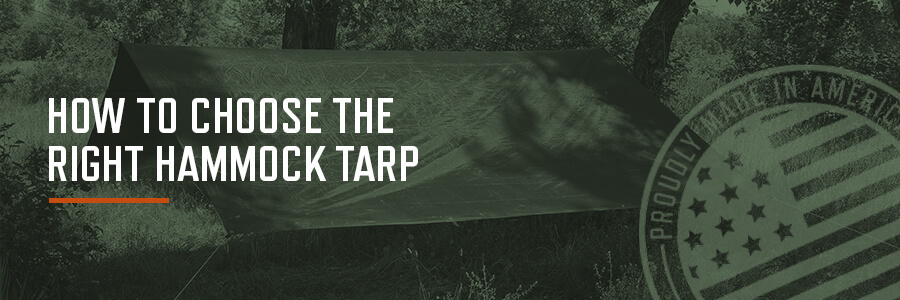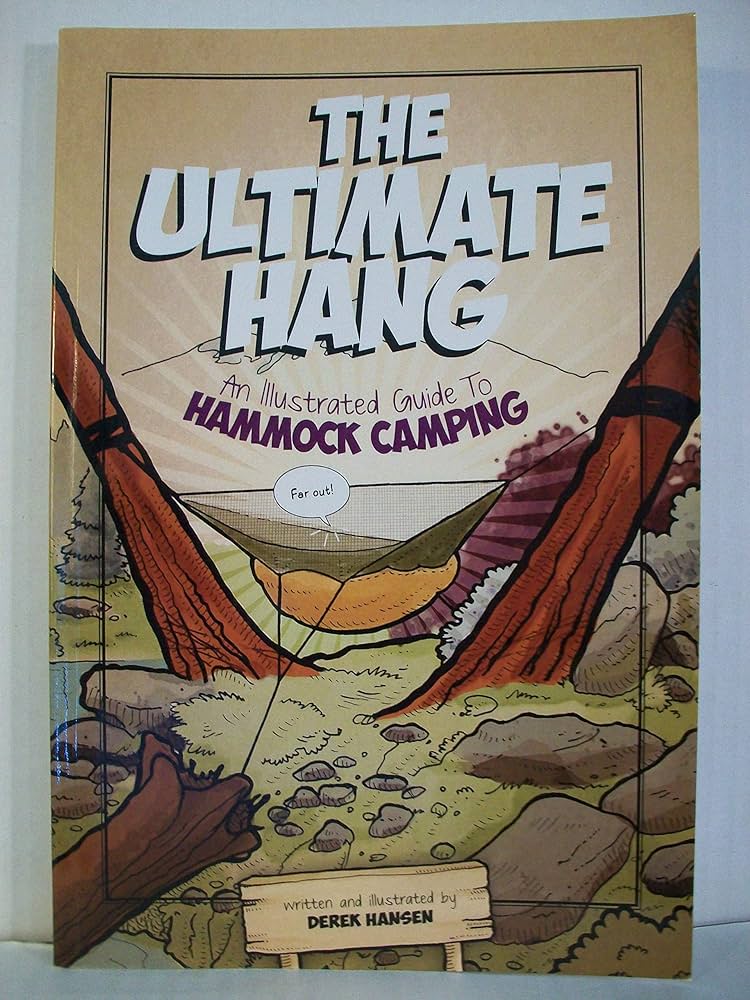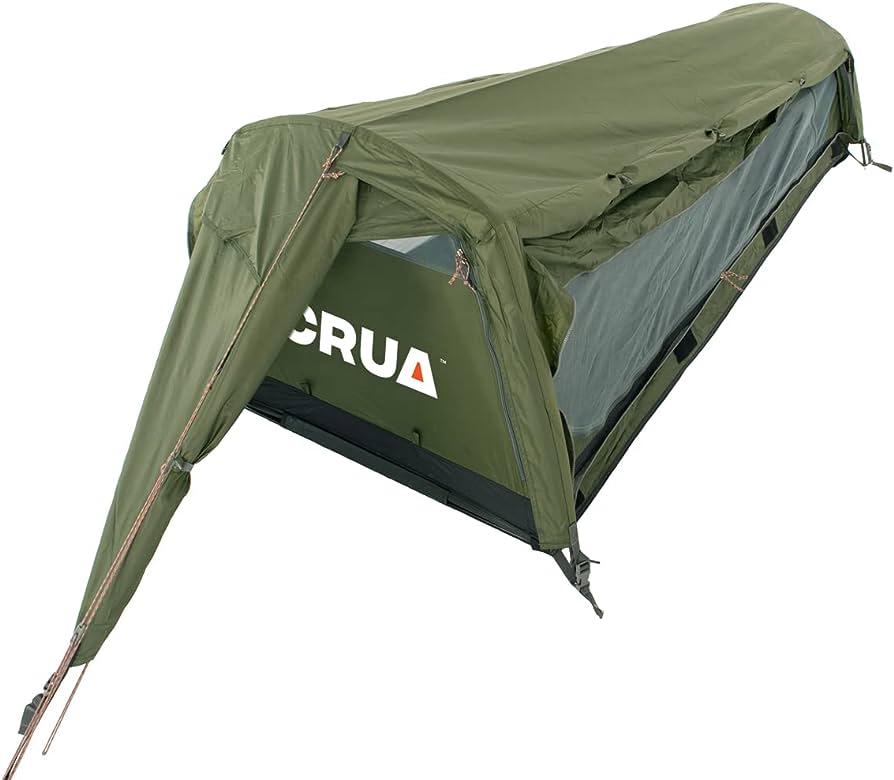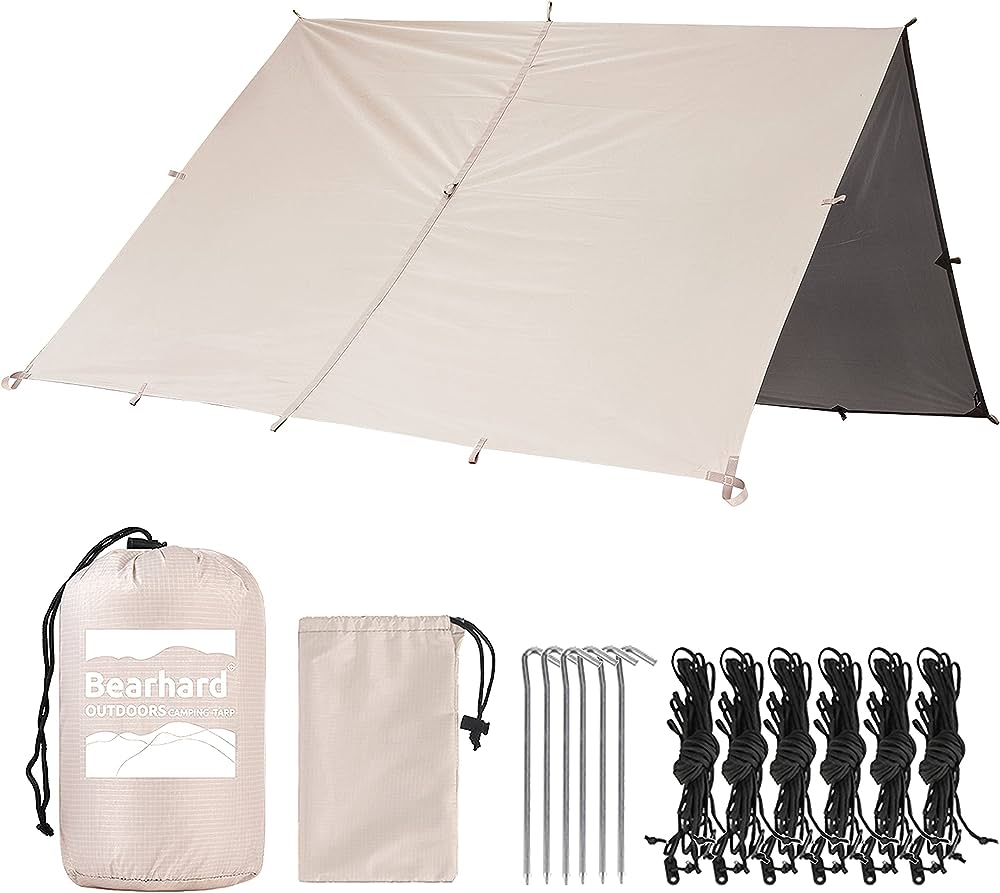- 8 Airplane Footrest Hammock!Travel comfortably - October 9, 2023
- top 7 Pool Float Water Hammock for a Relaxing Summer - October 9, 2023
- top 5 Space SaverSingle Hammock Stand Maximize Comfort and Space - October 9, 2023
Choosing a tarp for a hammock requires considering the size, material, and coverage it offers, as well as its durability and weight. When it comes to setting up a hammock, having a reliable tarp is essential.
Not only does it provide shelter and protect you from the elements, but it also adds an extra layer of comfort to your outdoor experience. With so many options available, choosing the right tarp for your hammock can seem overwhelming.
However, by understanding the key factors to consider, you can make an informed decision that meets your specific needs. We will explore the important aspects to keep in mind when selecting a tarp for your hammock, allowing you to enjoy your outdoor adventures without worrying about rain or sun exposure.
Understanding The Importance Of A Tarp For Hammock Camping
Understanding the Importance of a Tarp for Hammock Camping
When it comes to hammock camping, one item that often gets overlooked is the tarp. Yet, understanding the importance of a tarp is crucial for a successful and enjoyable camping experience. In this article, we will delve into the role of a tarp in hammock camping and explore the benefits of using one.
The Role Of A Tarp In Hammock Camping
The role of a tarp in hammock camping goes beyond just providing shade and protection from rain. It acts as a protective shield, shielding you and your hammock from the elements and potential hazards. Here are the key purposes that a tarp serves in your hammock camping adventure:
- Weather Protection: A quality tarp acts as an essential barrier against rain, wind, and snow. By providing a waterproof cover, it helps keep you dry and cozy throughout the night. No more worrying about waking up in a puddle or getting drenched during unforeseen weather changes.
- Bug Protection: Insects and bugs can quickly spoil your peaceful night’s sleep. A tarp effectively acts as a barrier against these unwanted guests, creating a bug-free zone in your hammock. Say goodbye to those frustrating mosquito bites and hello to uninterrupted sleep.
- Privacy: When camping in crowded areas or public campsites, having privacy can make all the difference. A tarp can create a private and secluded space, shielding you from prying eyes while allowing you to enjoy your camping experience with peace of mind.
- Additional Storage: A tarp can offer extra storage space for your gear, keeping it dry and easily accessible. No need to worry about finding room for all your belongings in your hammock. With a tarp, you’ll have everything within arm’s reach, but safely tucked away.
Benefits Of Using A Tarp For Hammock Camping
Using a tarp for hammock camping comes with several benefits that enhance your overall experience. Here are some advantages to consider:
- Lightweight and Portable: Tarps are lightweight and easy to carry, making them an ideal choice for backpacking and hiking trips. They won’t weigh you down, allowing you to enjoy the freedom of the outdoors without sacrificing essential protection.
- Cost-effective: Compared to purchasing a tent, investing in a tarp is a much more budget-friendly option. We all know that camping gear can add up quickly, but a quality tarp won’t break the bank while still providing the necessary coverage.
- Versatility: Tarps offer versatility in setting up your campsite. You can configure them in various ways to cater to your specific needs and environmental conditions. Whether you need extra shade, wind protection, or a makeshift dining area, a tarp can adapt to any situation.
- Easy Setup: Setting up a tarp is relatively quick and straightforward. Unlike tents, there are no complicated poles or frames to deal with. Simply hang it over your hammock, secure the corners, and you’re ready to relax and enjoy nature.
In conclusion, don’t underestimate the importance of a tarp for hammock camping. It serves as a protective shield, providing crucial weather and bug protection, privacy, and extra storage. By using a tarp, you can enjoy a comfortable and worry-free camping experience, protected from the elements while embracing the beauty of nature.
Factors To Consider Before Choosing A Tarp
Choosing the right tarp for your hammock is crucial for a comfortable and protected outdoor experience. With various options available in the market, it can be overwhelming to narrow down your choices. However, considering a few key factors can simplify the decision-making process and ensure you find the perfect tarp for your needs. In this post, we will discuss the important factors to consider before choosing a tarp for your hammock.
Size And Dimensions: Finding The Right Tarp Size For Your Hammock
One of the first things to consider when choosing a tarp is its size and dimensions. The tarp should be large enough to provide sufficient coverage for your hammock and protect you from the elements. A tarp that is too small may not effectively shield you from rain or wind, while an excessively large tarp may be cumbersome to set up and carry. To ensure a proper fit, measure the length and width of your hammock, and look for a tarp that is slightly larger to accommodate for adequate coverage.
Material And Durability: Different Tarp Materials And Their Pros And Cons
The material and durability of the tarp are important considerations, as they determine the tarp’s longevity and ability to withstand different weather conditions. Common materials for tarps include nylon, polyester, and silnylon.
Here is a breakdown of the pros and cons of each material:
| Material | Pros | Cons |
|---|---|---|
| Nylon | Durable, lightweight, and affordable | May stretch when wet |
| Polyester | Resistant to stretching and UV rays | Heavier than nylon |
| Silnylon | Lightweight and highly waterproof | More expensive than nylon and polyester |
Consider your specific needs and preferences to determine which material suits you best.
Weight And Portability: Considerations For Backpackers And Lightweight Campers
For backpackers and lightweight campers, the weight and portability of the tarp are crucial factors. A heavy tarp can add unnecessary weight to your backpack, making your outdoor adventures more exhausting. Look for lightweight materials such as nylon or silnylon, which are easy to carry without compromising durability and weather resistance. Additionally, consider the tarp’s packability – choose a tarp that folds down to a compact size for convenient storage and transportation.
Weather Resistance: Choosing A Tarp Suitable For Various Weather Conditions
The weather conditions you anticipate encountering should heavily influence your choice of a tarp. A reliable tarp should offer protection against rain, wind, and UV rays. Look for tarps with a high waterproof rating and reinforced seams to keep you dry during heavy downpours. Additionally, opt for a tarp with excellent wind resistance features, such as sturdy stakes and guy lines, to ensure it stays securely in place even in gusty conditions. UV resistance is also important to prevent the tarp from deteriorating under prolonged sun exposure.
Consider these factors carefully when selecting a tarp for your hammock to make an informed decision that will enhance your outdoor experiences and provide the necessary protection you need. Whether you are a backpacker, a camper, or simply enjoy spending time in nature, choosing the right tarp is essential for a comfortable and enjoyable outdoor adventure.
Types Of Tarps For Hammock Camping
Silnylon Tarps: Lightweight And Versatile Option
One of the most popular choices for hammock camping tarps is silnylon. Silnylon, short for silicone-coated nylon, is a lightweight and versatile material that offers excellent weather protection. It is highly regarded for its durability, water resistance, and windproof qualities. With its low weight, it’s an ideal option for backpackers and those who prefer to travel light.
Silnylon tarps come in various sizes and shapes, allowing you to choose the one that best fits your hammock setup. The most common shapes are rectangular and hexagonal. Rectangular silnylon tarps provide more coverage and better protection against the elements. On the other hand, hexagonal silnylon tarps are lighter and offer better visibility.
When setting up a silnylon tarp for hammock camping, it is essential to consider its attachment points and guylines. Most silnylon tarps come with reinforced tie-out points and integrated loops, making them easy to secure. Additionally, using adjustable guylines allows you to customize the tarp’s tension and adapt to changing weather conditions.
Polyester Tarps: Durable And Weather-resistant Choice
For hammock campers seeking a more durable and weather-resistant option, polyester tarps are worth considering. Made from woven polyester fibers, these tarps offer excellent resistance to abrasion, tearing, and UV rays. They are also known for their superior waterproof and windproof capabilities, making them a reliable choice for various weather conditions.
Polyester tarps are available in different weights and thicknesses, allowing you to choose the level of durability and weather protection that suits your needs. Thicker polyester tarps provide enhanced durability and are less prone to punctures or tears. They are particularly suitable for extended camping trips and harsh environments.
Cuben Fiber Tarps: Ultra-lightweight And High-performance Option
Cuben fiber tarps are known for their extraordinary strength-to-weight ratio, making them the ultimate choice for ultralight hammock campers. Constructed from high-performance laminated fabric, cuben fiber tarps are incredibly lightweight while offering exceptional protection from rain, wind, and UV rays.
These tarps are the ideal choice for backpackers who prioritize weight savings but don’t want to compromise on durability or performance. Cuben fiber tarps are resistant to stretching and have excellent tear resistance, ensuring they can withstand the rigors of long-distance treks or intense outdoor activities. Despite their feather-light construction, they provide reliable shelter and are easy to set up and pack away.
Canvas Tarps: Traditional And Heavy-duty Alternative
If you prefer a more traditional and heavy-duty option for hammock camping, canvas tarps are an excellent choice. Made from woven cotton fibers, canvas tarps are breathable, durable, and offer reliable protection against the elements.
Canvas tarps are particularly favorable for long-term camping or situations where weight is not a significant concern. They excel in durability, making them suitable for rugged terrains and extended use. These tarps also provide excellent insulation, keeping you warm during cooler nights.
However, it should be noted that canvas tarps are heavier and larger in size compared to other tarp materials, making them less suitable for backpacking or minimalist camping setups. Nonetheless, for those seeking a robust and long-lasting option, canvas tarps are an unbeatable choice.
Essential Features To Look For In A Hammock Tarp
Choosing the right tarp for your hammock is crucial to ensure a comfortable and protected outdoor experience. With a wide range of options available on the market, it can be overwhelming to select the perfect tarp. To help you make an informed decision, here are the essential features you should look for in a hammock tarp:
Ridgeline Tie-outs And Guyline Attachments
Ridgeline tie-outs and guyline attachments are vital features to consider when choosing a hammock tarp. These attachments allow you to secure the tarp to trees or other support structures, ensuring a taut and stable setup. Look for tarps with multiple tie-outs along the ridgeline and well-placed guyline attachments at the corners. This configuration enables you to customize the tension and angle of the tarp, providing optimal protection from the elements and enhancing your hammocking experience.
Reinforced Corners And Double-stitched Seams
When it comes to durability, reinforced corners and double-stitched seams are essential. These features enhance the longevity of the tarp by minimizing the risk of tearing or fraying, especially during strong winds or prolonged use. Reinforced corners are typically reinforced with additional material or extra stitching, while double-stitched seams provide added strength and prevent seam failure. By selecting a hammock tarp with these reinforced features, you can have peace of mind knowing that your tarp will withstand the elements and endure outdoor adventures.
Ample Coverage And Sufficient Clearance
Ample coverage and sufficient clearance are critical aspects to ensure complete protection and comfort while hammocking. Your chosen tarp should have enough coverage to shield you from rain, wind, and the sun’s harmful rays. Pay attention to the dimensions and shape of the tarp, as well as its overall coverage area. Additionally, make sure the tarp provides sufficient clearance, allowing you to comfortably sit or lie in your hammock without feeling cramped or restricted. Adequate coverage and clearance will enhance your hammocking experience and enable you to fully enjoy the great outdoors.
Easy Setup And Adjustability
The ease of setup and adjustability of a hammock tarp can greatly impact your overall camping experience. Look for tarps that come with user-friendly features like integrated tensioning systems, quick-release buckles, or adjustable cords. These features will make it easier and quicker to set up your tarp, even in challenging weather conditions. Additionally, opt for a tarp that offers adjustability, allowing you to fine-tune the tension and positioning to match your preferences and the prevailing weather conditions. An easily adjustable tarp will provide you with more flexibility and convenience during your outdoor adventures.
Compatibility With Hammock Accessories And Suspension Systems
Compatibility is a crucial consideration when choosing a hammock tarp. Ensure that the tarp is compatible with your hammock accessories and suspension system. Look for features like attachment points or loops that can accommodate additional gear such as bug nets, underquilts, or gear lofts. Compatibility will enable you to seamlessly integrate your tarp with other hammock accessories, providing enhanced functionality and customization. Before making your purchase, carefully check the compatibility details to ensure a perfect fit for your hammock setup.
Tips For Maintaining And Caring For Your Hammock Tarp
Once you’ve chosen the perfect tarp for your hammock, it’s crucial to take proper care of it to ensure its longevity and performance. Proper maintenance and regular inspections are key to ensuring your tarp continues to provide reliable protection from the elements. In this section, we will discuss some essential tips for maintaining and caring for your hammock tarp.
Cleaning And Drying Your Tarp Properly
Regular cleaning is essential to remove any dirt, debris, or mildew that may accumulate on your hammock tarp. To clean your tarp, gently wipe it down with a damp cloth and a mild soap solution. Avoid using harsh chemicals or abrasive scrub brushes, as they can damage the waterproof coating.
After cleaning, it’s crucial to thoroughly dry your tarp before storing it. Moisture trapped in the fabric can lead to mold and mildew growth, compromising the tarp’s integrity. Hang your tarp in a well-ventilated area, away from direct sunlight, until completely dry.
Proper Storage And Transportation To Prolong Its Lifespan
The way you store and transport your hammock tarp plays a vital role in prolonging its lifespan. When not in use, fold your tarp neatly and store it in a dry, cool place, preferably in a breathable bag or container. Avoid storing it in a tightly packed or humid environment, as it can damage the fabric and waterproof coating.
When transporting your tarp, make sure it is securely stored and protected from sharp objects or rough handling that could cause tears or punctures. Consider using a dedicated tarp sack or a compression sack to keep it safe during transportation.
Inspecting For Any Damages Or Wear And Tear
There are several visual cues you can look for when inspecting your hammock tarp for damages or wear and tear. Check for any tears, holes, or abrasions in the fabric, as well as any loose or deteriorating stitching. Additionally, pay attention to the condition of the grommets, loops, and cords that are attached to the tarp. If you notice any signs of damage, it’s essential to address them promptly to prevent further deterioration.
Patching And Repairing Minor Tears Or Holes
In the event of minor tears or holes in your hammock tarp, it’s possible to patch and repair them. Investing in a repair kit specifically designed for tarps is a wise decision. Follow the manufacturer’s instructions to patch the damaged area with the appropriate adhesive or patch material. This will help prevent further damage and maintain the tarp’s performance.
Re-waterproofing When Necessary
Over time, the waterproof coating on your tarp may start to wear off, especially with prolonged use and exposure to the elements. When you notice reduced water repellency or signs of saturation, it’s time to re-waterproof your hammock tarp. Follow the manufacturer’s recommendations to apply a waterproof treatment specifically designed for your tarp’s fabric type.
By following these tips for maintaining and caring for your hammock tarp, you can ensure that it remains in peak condition for many adventures to come. Taking the time to inspect, clean, repair, and re-waterproof as needed will help extend the lifespan of your tarp, providing you with optimal protection and peace of mind during your outdoor excursions.

Credit: dutchwaregear.com
Frequently Asked Questions For Choosing A Tarp For A Hammock
Q: Can I Use Any Tarp With A Hammock?
A: Yes, you can use any tarp, but it’s important to consider the size, material, and weather resistance.
Q: What Size Tarp Do I Need For A Hammock?
A: For a standard hammock, a tarp measuring approximately 10ft x 10ft is recommended.
Q: Should I Choose A Lightweight Tarp For Backpacking?
A: Yes, a lightweight tarp is essential for backpacking, as it ensures easy transportation and reduces overall weight.
Q: What Materials Are Suitable For Hammock Tarps?
A: Ripstop nylon and polyester are popular choices due to their durability, water resistance, and lightweight properties.
Q: Are All Hammock Tarps Waterproof?
A: Not all hammock tarps are waterproof. It’s important to check the specifications and look for tarps labeled as waterproof or water-resistant.
Q: Can A Tarp Provide Protection From Insects?
A: Yes, some tarps are specially designed with mesh netting to provide protection from insects while hammocking.
Conclusion
Selecting the right tarp for your hammock is crucial for ensuring a comfortable and protected outdoor experience. By considering factors such as material, size, and weather resistance, you can find a tarp that fits your needs perfectly. With the right tarp, you can confidently hang your hammock and enjoy the great outdoors, rain or shine.




